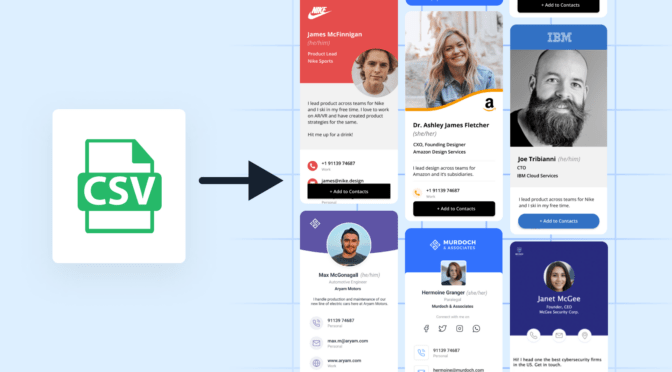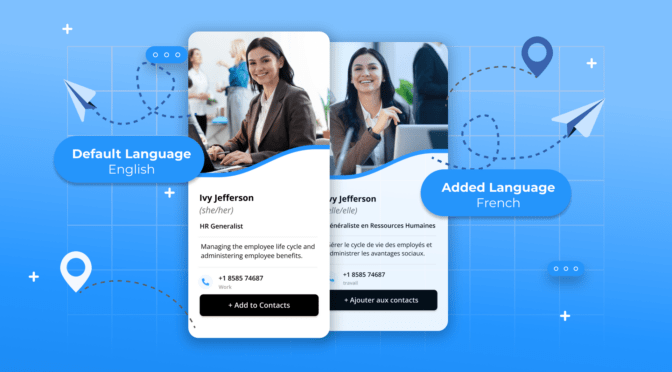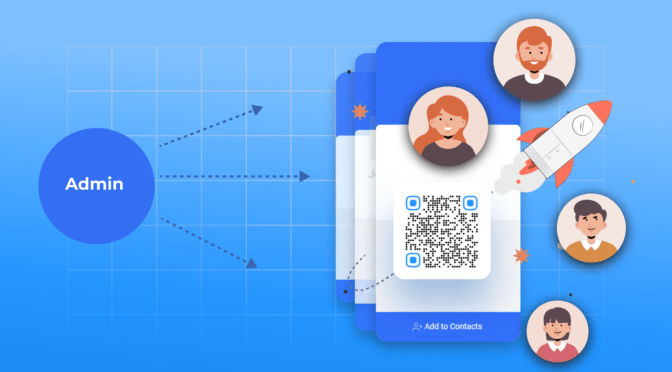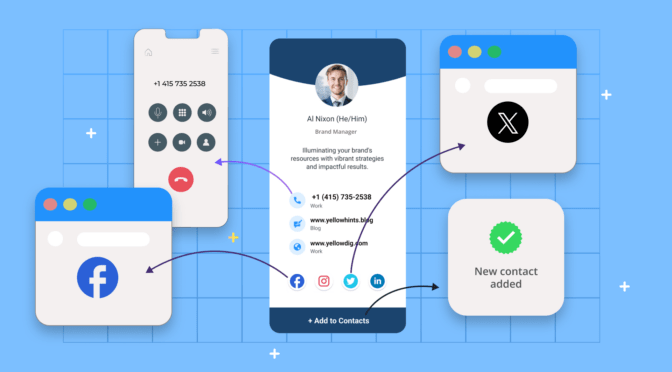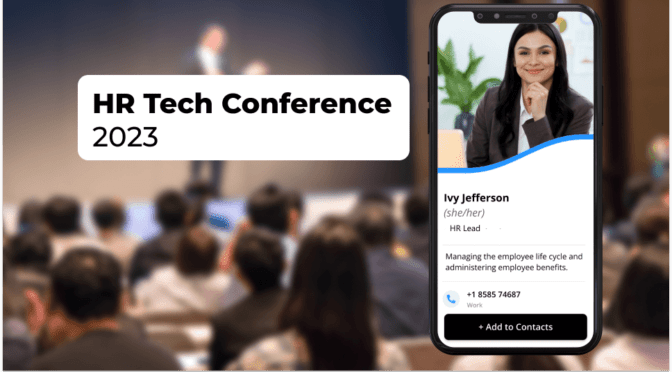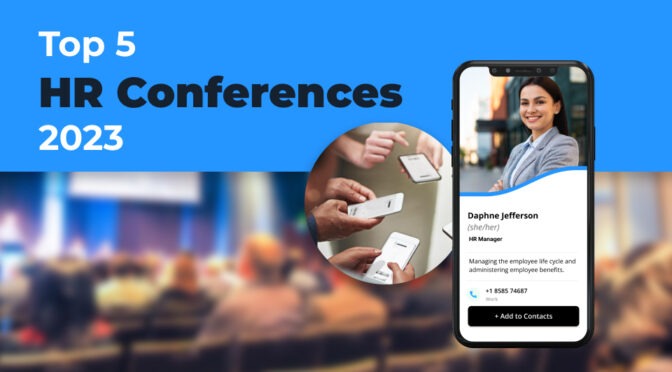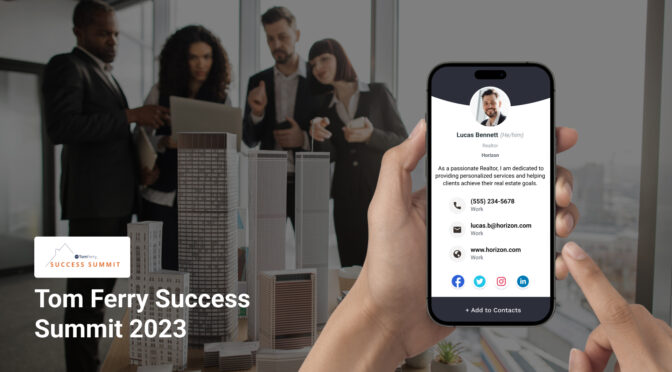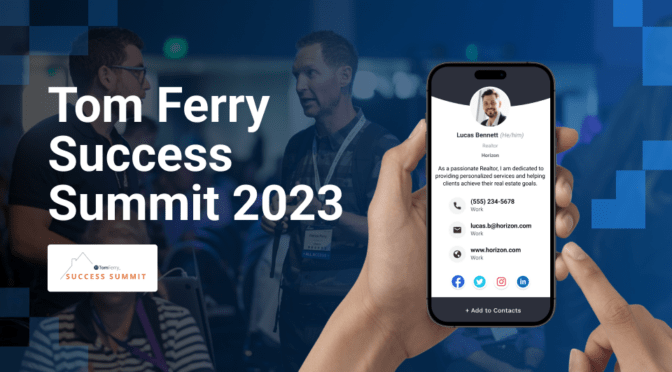Imagine you’re ready to showcase your product or service at an event. Your booth is up and running. People interact with your reps, exchange business cards, and leave for the next booth.
Your event lead capturing form is tedious to fill out, inevitably leading to drop-offs. For most visitors, badge scanners are another dull, monotonous, and unavoidable part of visiting your booth—just like it is for hundreds of others.
In the post-event shuffle, your team is left with a heap of business cards—unsure which is hot, warm, or cold lead. The result is guesswork, overwork, and, in the end, futile efforts.
So, how do you capture event leads most effectively? Are there foolproof methods to capture leads at events? What tools can you use for this?
We’re here to answer all your questions. Keep reading to know more.
6 Tools to capture leads at events (& how to use them)
You can use multiple tools to capture event leads effectively. Here are seven tools to help you here:
1. Digital business cards
Let’s say you’re attending a networking event and meet a potential lead interested in your product. Instead of fumbling for a physical business card, you can swiftly exchange contact information digitally using digital business cards.
These digital alternatives of paper business cards provide an efficient and paperless way to network and capture leads during events or business interactions.
The best part is that you do not have to be physically present in the booth to capture leads. You can simply use a QR Code that is easily accessible, and one can scan to access your contact details and more, virtually. Use a clear CTA such as “Scan for my contact details.”
Upon scanning the QR Code, your details, such as name, contact details, designation, etc., will automatically appear on a prospect’s phone. They can click to save your contacts on their mobile device.
⚡Pro tip: Collect your prospects’ contact details using the same digital business card with Uniqode.

- Use two-way contact sharing to capture leads the instant you share yours
- Share your e-business cards via Apple Wallet or Google Wallet
- Track the number of leads and their details on an intuitive dashboard
- Transfer leads to your existing CRM and nurture them further
2. NFC devices
A more unconventional way to capture leads at events is to use Near-Field Communication (NFC) devices. NFC devices use radio frequency for contactless communication.
Although NFC can be less effective than digital business cards, it is still popular. You can share information or scan badges in one go, making information exchange paperless and straightforward.
NFC devices come as tags, wristbands, or even apps. For instance, InEvent, an event management platform, offers NFC wristbands to attendees. These wristbands help attendees gather information about a product or service by scanning a QR Code or doing a contactless exchange through NFC. Furthermore, you can consider NFC-based apps such as NFC Leads to share your contacts, send automatic emails, and share essential documents directly with your contacts.
3. QR Code reader apps
Next up, you can consider mobile apps to capture leads at events at the flick of your wrist. Having an app handy that can scan badges or read QR Codes can speed up lead collection.
You can use these apps during booth interactions or networking events to collect information on your leads. iCapture, for instance, is an app that can scan QR Codes and details written on badges or business cards. Similarly, Boomset is another app that can collect contact through QR Codes and even RFID chips when a mobile device is compatible. Additionally, Boomset’s analytics dashboard can provide practical insights into attendee data, that you can use for cold outreaches.
4. Lead capture forms
Lead capture forms can be an easy way to capture event leads. Multiple points during an event can be used to ask a lead to fill out a form.
Handing out paper forms is less favorable, given the time and effort it takes to fill them out. Instead, share QR Codes to redirect the leads to digital forms during booth interactions, networking sessions, or product demos. Alternatively, you could share forms for a feedback survey and collect contact details from leads.
When a lead voluntarily provides their information through a form, you can directly engage, guiding them through the marketing funnel.
Simple tools like Google Forms or Typeform can create online lead capture forms. Although these forms are not highly customizable, they can capture all the data you require from a lead. You can use these forms tools to integrate with other tools with Pluga. On the platform, you can automate your lead capture. For example, you can integrate Google Forms with HubSpot for each new response on Google Forms, create or update a contact on HubSpot. If you link these forms to a QR Code, your easy data collection method is in place. For instance, some tools can create QR Code-based lead capture forms, while others, like Mailchimp, have highly customizable templates but do not offer QR Codes.
⚡Pro tip: Make your lead capture forms more interesting. Create QR Code-based lead capture forms with logic jumps for a highly personalized experience. Use Uniqode forms.

Add logic jumps into your form or quiz and create a customized user pathway based on their responses. Provide a streamlined user experience without wasting your lead’s time.
5. Event organizing/ management tools
Event management tools are typically used to plan and manage an event digitally. But they can also capture leads at events.
For instance, Social Tables is an event management tool that easily captures leads. You can create an event website and enable the lead capture feature for a trade show, which collects the data of all those who browse your event page.
Even if you forget to collect a lead’s contact information or have many attendees visiting your website, their information will be collected automatically. However, you need to read Social Tables’s data privacy policies to understand how they use their data.
6. Use CRM tools
CRM, or customer relationship management tools, can be useful in capturing event leads. There are various touchpoints before and during events when you can use these tools to get lead data.
CRM systems like Salesforce can streamline online registration and check-in at the event by capturing attendee information directly into the database. This ensures that leads are captured during the registration for the event or checking in at the venue.
For instance:
- Using Salesforce mobile apps, you can capture lead information using mobile devices
- You can do real-time data entry using the Salesforce mobile app to capture leads in person during the event
- You can integrate Salesforce with various event management platforms and lead retrieval devices
- Using Salesforce’s automation capabilities, you can set up automated workflows for lead follow-up and nurturing, such as email sequences, tasks, or alerts triggered by specific lead actions or milestones
We’ve explored the tools that can get leads to notice and sign up with you. Now, let’s delve deeper into what other essential practices you can follow to capture leads at events successfully.
Best practices to capture leads at events
It is essential to incorporate certain practices to increase engagement and conversion rates. Some of them are as follows:

1. Digitalize lead capture processes
Digitalizing capturing leads at events rather than manually is a sound way to rule out human errors, make the process efficient, and save time. Here are some steps you can take:
- Replace paper-based forms and visiting cards with digitized ones and easily scannable QR Codes
- Capture prospects’ details the instant you share yours. You can do so using Uniqode’s digital business card solution
- Set up interactive kiosks with touchscreens or tablets at strategic locations throughout the venue. Prospects can use this to enter their information and preferences and capture leads
Use paperless and instant information-sharing such as QR Codes through various channels to increase efficiency
2. Track engagement and analytics
Tracking data and engagement after an event is crucial for evaluating the success of your lead capture methods. Here are some examples:
- Identify the metrics that work for you and are a measure of your success. For instance, focus on the engagement rate of a particular social media campaign and understand how many leads came to your landing page from social.
- Track how well your digital business cards have performed to determine whether a lead is hot or cold. If you use Uniqode, the dashboard has an “Analytics” section that gives information on card views, saved contacts, and the number of unique users your digital business card reached.
- Follow up on click-through and response rates in your ads, landing pages, forms, and so on to gauge the effectiveness of the post-event communication strategies.
- Monitor your event social wall analytics to see which posts generate the most engagement and identify active participants who could be potential leads worth following up with. Walls.io is one such product that can aid in this process.
Analyze email marketing campaigns sent before, during, and after the event—track email open rates, click-through rates, conversions, and follow-up interactions. MailChimp is one such tool that can aid in this process.
3. Segment & prioritize leads
Distinguish and categorize leads during events to concentrate your efforts on those most likely to convert. One effective method is implementing lead scoring systems that assign points based on various criteria such as engagement level, demographics, or specific actions.
For example, if you’re at a technology expo, you might prioritize leads participating in a product demonstration or engaging in a detailed conversation about your offerings.
4. Set up future touchpoints
Establishing touchpoints with leads to keep them engaged beyond the event is crucial. Here are some examples:
- Connect with leads on LinkedIn during the event. Later, you can share relevant content, respond to comments or messages, and participate in discussions on LinkedIn to build relationships.
- Follow up with your leads through personalized emails to continue the conversation, provide additional information about your products or services, and nurture the relationship over time.
Conduct internal webinars or other online events, allowing further engagement and interaction with leads.
5. Choose a secure platform for lead capture
To protect sensitive information, it is essential to opt for secure platforms—whatever technology you use—with robust data encryption and compliance measures. It is also crucial to provide attendees with transparent information about data collection and obtain explicit consent before collecting their information. It helps build trust and demonstrates your commitment to privacy.
6. Add value during lead collection
Providing value to leads during the data collection process is essential to avoid coming across as intrusive.
Offer incentives or rewards in exchange for their information. For instance, offer exclusive discounts, access to premium content, e-books, brochures, or entry into a giveaway. This can incentivize attendees to share their contact details willingly.Get to know your leads personally. Understand your audience’s interests better and see if you can establish a product-people connection before you urge them into the sales funnel. Identify their pain points and explain how your product can be the perfect solution.
7. Be transparent with your leads about data collection
Transparency is key when collecting data at events. Communicate how their information will be used, stored, and protected.
Provide a privacy notice or disclaimer at registration points or on lead capture forms outlining your data collection practices and the purposes for which the data will be used.
Give attendees control over their data by allowing them to opt in or opt out of communications and specifying how they can update their preferences or request the deletion of their information.
Start your lead capture journey now
There are many ways to capture leads at events, including using digital tools such as e-business cards and lead-collection apps, CRMs, social media, and online forms.
Going digital speeds things up and helps you better understand your leads’ interests. By tracking how things go after the event, you can fine-tune your approach for future events.

Frequently asked questions
1. What does capturing leads at events mean?
Capturing leads at events refers to collecting contact details and other relevant information from individuals who have shown interest in a particular product, service, or company at an event. This event could be a seminar, trade show, conference, or any such gathering. These individuals are potential customers or clients who have expressed interest in the offerings presented at the event. The gathered information is then utilized for subsequent follow-up communication and marketing efforts to nurture these leads and convert them into paying customers or clients.
2. What is the best way to capture leads at events?
To capture leads at events successfully, you need to have a strategic plan, effective tools, and engaging interactions. The first step is to set clear objectives and define the target audience to ensure that your efforts are focused. To streamline data collection and enhance attendee engagement, use digital tools such as mobile apps, QR Codes, or NFC devices. Integrating CRM systems will also enable smooth lead management and personalized follow-up actions after the event.
3. Why is it important to capture leads?
By capturing leads, businesses can create a database of prospects to nurture and convert into paying customers over time. Ultimately, effective lead capture helps businesses boost sales, grow their customer base, and maximize revenue opportunities.
Sukanya is a Content Marketer at Uniqode and a former journalist who fuses newsroom curiosity with SEO-savvy storytelling to help brands grow online. She’s on a mission to demystify digital business cards, digging deep into data, trends, and user behavior to spotlight how they transform how we network and generate leads. Her content doesn’t just inform—it equips. Outside the digital realm, she’s either rescuing animals, getting lost in a plot twist, whipping up kitchen experiments, or chasing stories worth telling.










